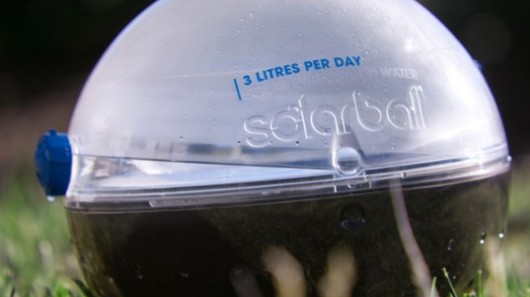
When he set out on a trip to Cambodia in 2008, Industrial Design student Jonathan Liow had no idea it was going to be a life-changing experience. Upon seeing the poverty and poor living conditions in that country, however, he decided that he wanted to build things that could help people. After hearing about the need for cheap and effective water purification in Africa, he proceeded to create the Solarball for his graduate project at Australia’s Monash University. The ball is reportedly capable of producing 3 liters (about 3 quarts) of drinkable water per day, using nothing but polluted water and sunlight.
A very cool device.















The industries absolutely hate products like this.
There are no batteries to buy, no chemicals to add, no power requirements, no add-ons or gimracks or gee-gaws.
What can you do with a device with no after market?
I predict that this device will be a commercial failure. 🙂
Well done Liow
This is good
Imagine the results if we stop putting money into tomahawk missiles and shift it to this
Yea right!
If federal money was set aside to work on projects like this, sooner or later it would be funneled into making deadlier cruise missles.
There’s nothing particularly new about a solar still. Back in the 1970s I recall a book with instructions to build one that was basically an A frame with a glass roof and a pool of dirty water in the middle and gutters along the bottom rails of the “roof” to collect the water.
Making a cheap to mass produce, easily transportable one that can be distributed to destitute people in remote sections of the world is new, however.
@spsffan – in it’s Della Porta’s 16C book on optics.
It’s hard to see from the image – but the trick to making it work in practice is getting the water out without losing the hot air. A stray is the best way
Actually, there is NOTHING new about this “technology.” Every survival kit should include a 3 foot plastic square. “In the wild” just dig a hole where the sun shines, dump in your liquid source, cover the hole with the plastic wrap, cover the edges of the wrap with dirt to make it airtight, then place a pebble in the middle of the plastic. Water will form on the tarp and drip to the center of the piece of plastic and drip back into the hole. If you thought ahead and put a tin can at the bottom of the hole, you will have drinking water every day.
I think nautical survival kits have a “blow up” plastic ball that does much the same thing. Its all good, can’t have too many approaches to get clean water to every human being.
#6…
That is two very different things. I remember your solution from boy scouts. But that captures moisture night air. This is a solar distiller.
How much water does a human need? Is 3 qts enough for a day?
And this solarball will cost about $300.
#7…
Thanks for pointing that out. I post moronic vitriolic comments on stuff I know nothing about every day.
[Har! – ed.]
#7 That might suffice in a cool shady location. In a hot dry climate you will need a heck of a lot more than that.
A good inflatable solar still that produced less water was listed starting at 200.
Since this doesn’t need to be transportable I’d think some large black plastic bags leaning against a black painted adobe or block wall could supply the heat and a plastic tube could lead to a condenser in the shade for rather less than the price asked.
This sort of thing works for creating limited amounts of drinking water but when scaled up for producing the amounts Americans expect to use they can take up a lot of space.
If you shifted military spending to projects like this soon you would have cruise missiles that are solar powered.
Bobbo is correct – this is a solar still.
The plastic bag stretched over a hole collects water on the UNDERSIDE of the plastic. You put dirty water into the depression, or allow dirty ground water to seep in. The stone is just to make the cover cone shaped so that the evaporated clean water drips down to a container you put in the center underneath the plastic – the trick is then to drink the water from the container though a straw without letting the hot air out.
deowll,
This may not be “useful” to wasteful water users, but don’t forget almost hafl the planet doesn’t have access to clean water of any kind.
Also remember that 3 quarts is 12 cups. Even in America it is only recommended that we drink 6 – 8 cups of water/fluid a day.